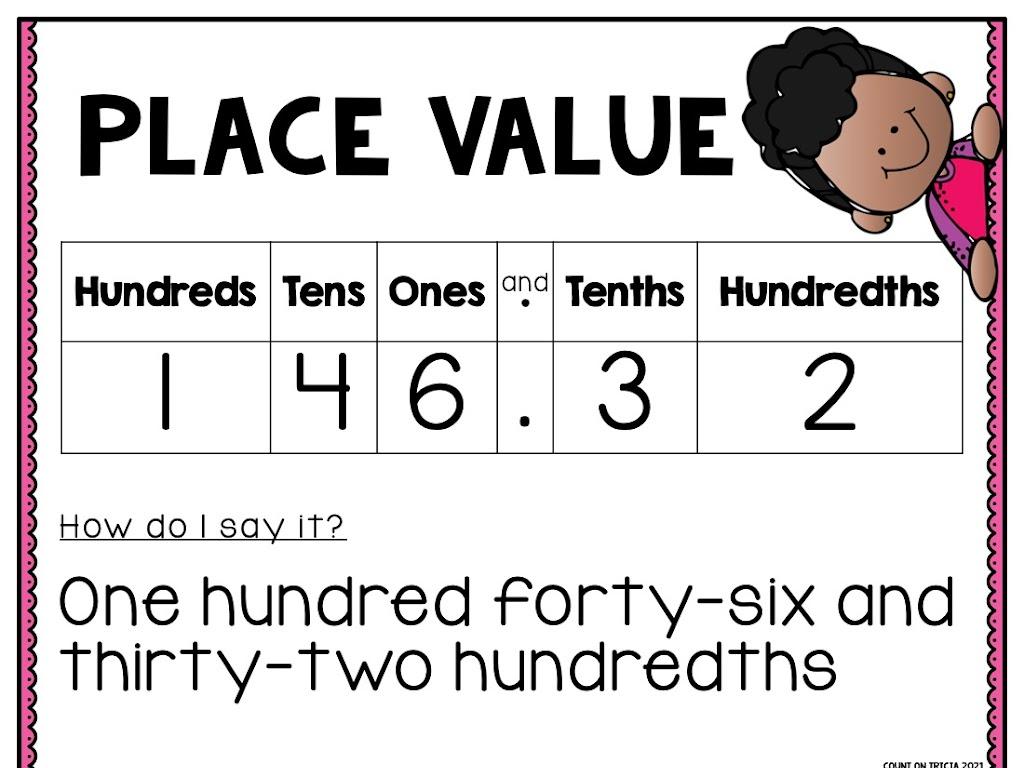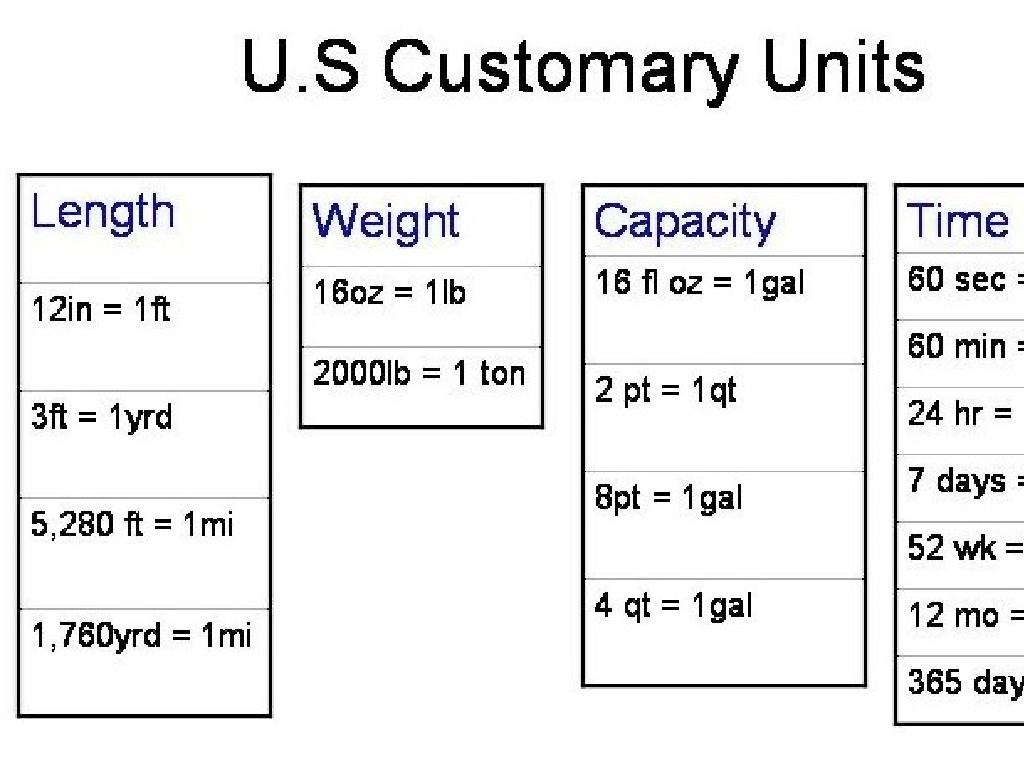Scalene, Isosceles, And Equilateral Triangles
Subject: Math
Grade: Fourth grade
Topic: Triangles
Please LOG IN to download the presentation. Access is available to registered users only.
View More Content
Introduction to Triangles
– What is a Triangle?
– A shape with three straight sides and three angles
– Basic properties of triangles
– Each has three edges, three vertices, and angles that add up to 180°
– Triangles are 3-sided polygons
– A polygon is a shape with straight sides; triangles have the least number of sides possible
|
Begin the lesson by defining a triangle as a three-sided shape, emphasizing the concept of straight sides and angles. Discuss the basic properties, such as the sum of angles always being 180 degrees, and the terms ‘edges’ and ‘vertices.’ Explain that triangles are the simplest form of polygons, which are any closed figures with straight sides. Use visual aids to show different types of triangles and polygons. Encourage students to draw their own triangles and identify the sides and angles to reinforce their understanding. This foundational knowledge sets the stage for learning about more complex shapes and geometry concepts.
Exploring Triangle Types
– Triangles have different types
– Like people, triangles are unique! No two types are the same.
– Classify by sides and angles
– Some triangles have equal sides or angles, others don’t.
– Today’s focus: Scalene, Isosceles, Equilateral
– Scalene: All sides different. Isosceles: Two sides the same. Equilateral: All sides equal.
|
This slide introduces the concept that triangles can be categorized based on their sides and angles. It’s crucial to help students visualize and differentiate between Scalene (no equal sides), Isosceles (two equal sides), and Equilateral (three equal sides) triangles. Use real-life objects that resemble these shapes to make the lesson tangible. Encourage students to draw examples of each type and to think about where they might see such shapes in their environment. This will set the foundation for understanding more complex geometric concepts.
Exploring Scalene Triangles
– Scalene triangles: all sides different
– No sides or angles are the same in scalene triangles.
– Real-world scalene examples
– Examples: A triangle-shaped plot of land with all different side lengths.
– Recognizing scalene triangles
– Look for triangles with no equal sides or angles.
– Orientation doesn’t change type
– Whether upright or tilted, scalene triangles keep their properties.
|
This slide introduces scalene triangles to fourth-grade students by defining their key characteristics: no equal sides and no equal angles. Provide relatable examples, such as differently measured sides of a triangular garden plot, to help students visualize. Emphasize the skill of identifying scalene triangles regardless of their orientation, reinforcing that a triangle’s type is determined by its sides and angles, not its position. Encourage students to draw their own scalene triangles and to find objects around the classroom or at home that resemble scalene triangles to enhance their understanding.
Exploring Isosceles Triangles
– What is an Isosceles Triangle?
– A triangle with two equal sides and angles
– Isosceles Triangle Examples
– Like a mountain or a slice of pizza
– Properties of Isosceles Triangles
– They have two equal sides and angles, and one different
– Isosceles Triangles in Shapes
|
This slide introduces students to the concept of isosceles triangles, which are triangles with two sides of the same length and two angles of the same measure. Use relatable examples such as a mountain peak or a slice of pizza to help students visualize isosceles triangles in real life. Discuss the properties, emphasizing that the base angles are equal, and the sides opposite those angles are also equal. Encourage students to identify isosceles triangles in various shapes and objects around them. This will help solidify their understanding of the triangle’s properties and how to recognize them.
Exploring Equilateral Triangles
– What is an Equilateral Triangle?
– A triangle with all sides equal and each angle 60 degrees.
– Equilateral Triangle Examples
– Think of a perfect triangle-shaped cookie.
– Equilateral Triangles are Symmetrical
– Fold it in three ways to see equal parts.
– Equilateral Triangles in Real Life
– Like a road sign or a piece of art.
|
This slide introduces students to equilateral triangles by defining their properties: all sides of equal length and all internal angles being 60 degrees. Use tangible examples like a triangle-shaped cookie to help them visualize. Discuss the concept of symmetry by demonstrating how an equilateral triangle can be folded in three equal parts, each reflecting the other. Relate the concept to real-life objects that students can easily recognize, such as triangular road signs or pieces of artwork. Encourage students to find and bring examples of equilateral triangles they see in their daily lives to the next class for a show and tell.
Comparing Triangle Types
– Scalene triangles: all sides different
– No sides are the same length, and angles are different
– Isosceles triangles: two sides equal
– Exactly two sides are the same length, and angles may be the same
– Equilateral triangles: all sides equal
– All three sides are the same length, and all angles are 60 degrees
– Identifying triangles by sides and angles
– Look for equal sides or angles to determine the type of triangle
|
This slide aims to help students visually and conceptually differentiate between scalene, isosceles, and equilateral triangles. Emphasize that in scalene triangles, all sides and angles are different, which makes them unique. In isosceles triangles, two sides are of equal length, often leading to two equal angles. Equilateral triangles are special because every side and angle is the same, with angles always being 60 degrees. Encourage students to use these characteristics to identify triangle types. Prepare an interactive Q&A session where students will be shown different triangles and asked to classify them based on their understanding. This will reinforce their learning and provide an opportunity for immediate feedback.
Class Activity: Classify the Triangles
– Work in pairs on triangle worksheets
– Classify triangles by sides and angles
– Scalene: all sides different; Isosceles: two sides equal; Equilateral: all sides equal
– Discuss your reasoning with your partner
– Explain why you think a triangle is scalene, isosceles, or equilateral
– Share findings with the class
|
In this interactive class activity, students will pair up to work on worksheets that have various triangles depicted. The goal is for them to classify each triangle as scalene, isosceles, or equilateral based on the length of the sides. Encourage students to articulate their thought process to their partners, fostering communication and critical thinking skills. After the activity, have a few pairs share their classifications and reasoning with the class. This will help reinforce the concepts and allow for a group discussion. Possible variations of the activity could include having students measure sides with rulers, use protractors to measure angles, or create their own triangles using art supplies.
Triangle Review and Homework
– Recap: Types of Triangles
– Scalene: all sides different, Isosceles: two sides equal, Equilateral: all sides equal
– Importance of Triangle Types
– Knowing triangle types helps in geometry, construction, and understanding shapes around us
– Homework: Triangle Hunt
– Find real-life triangles: Scalene, Isosceles, and Equilateral
– Be ready to share examples
– Share your triangle findings in our next class!
|
This slide aims to consolidate the students’ understanding of the different types of triangles. A quick recap of the key characteristics of Scalene, Isosceles, and Equilateral triangles will help reinforce their knowledge. Emphasize the practical importance of recognizing these shapes in various fields such as architecture, art, and nature. For homework, students are tasked with a fun and engaging activity to find examples of each type of triangle in their surroundings. This will help them apply their knowledge in a real-world context and prepare them to share their discoveries in the next class, fostering a collaborative learning environment.





